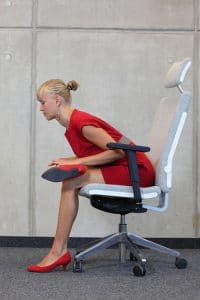Most people know that it’s important to regularly exercise in order to be healthy, and it’s widely acknowledged that a sedentary lifestyle–one where there is little to no physical activity–can lead to severe health issues. And while many of us make an effort to walk, run, or do some other type of physical exercise at least 2-3 times per week, how many of us are mindful of how we sit?
The typical workday is 8 hours; and in a sedentary occupation, those 8 hours are typically spent sitting while staring at a computer screen. Add to that the time that many people spend commuting to their places of employment, multiplied by however many days are in that person’s work-week, and you get the quintessential “sedentary lifestyle” where the bulk of time is spent sitting down.
If sitting down for most of the day is unavoidable, as it is for many of us, what then can be done to mitigate the ill-effects of such a sedentary lifestyle?
As someone who also sits for a living, and is sitting at this very moment while composing this blog entry, I suggest you ditch the chair and sit on the floor, if at all possible. The reason for this is simple. Most chairs force the body into unnatural (non-ergonomic) positions that are unsustainable for long periods of time. Muscles no longer work to support the body’s weight, and there are few if any opportunities for the frame to stretch. Conversely, on the floor, it’s much easier to assume a wider variety of sitting positions and the body naturally strengthens by supporting itself against gravitational forces. If sitting on the floor is not a practical or pragmatic solution, chairs can also be used in creative ways…
Here are some examples of healthier, more ergonomic positions for the body, in a chair. Please note that in both examples the models have straight backs, even when leaning forward at the waist, and are supporting their bodyweight under their own strength.
- Half Chair Pose
- Half Lotus Pose
Both of these basic hatha yoga poses have numerous physiological and psychological benefits. Specifically, they both promote better circulation of the blood, oxygen, lymph, and other energies of the body. The half-lotus pose is even said to increase digestive efficiency–promoting excess weight loss. This enables practitioners of these chair asanas to better breathe, think, and feel more energized–despite sitting for long periods of time. In fact, there is an oft-cited study (Bae 2012) that points to the virtues of sitting on the floor for sufferers of chronic lower-back pain. If you’d like to try these poses for yourself, please remember to respect your body’s limitations, especially if you have lower-body joint issues; start slowly, and see what feels comfortable. Also, seek the guidance of a capable yoga teacher if you’d like to delve deeper into a more serious practice.
Examining your sitting habits is a great way to improve your general health, as it both benefits the body and mind. Do you spend most of your time sitting on a couch; on an office chair; or in the passenger seat of a car? If so, look at ways to improve how you sit, and comment below on your results!



